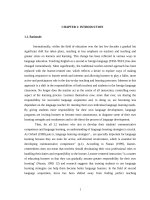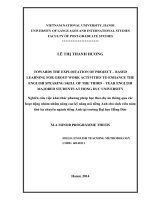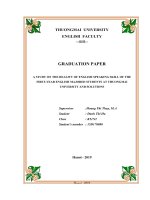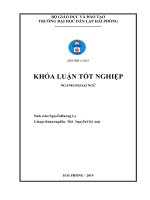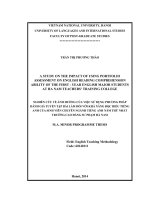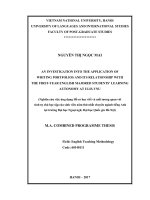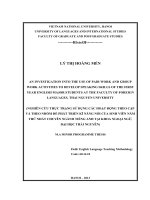AN INVESTIGATION INTO ABILITY TO DISTINGUISH “WILL” AND “BE GOING TO” OF THE FIRST YEAR ENGLISH MAJORED STUDENTS AT TAY NGUYEN UNIVERSITY
Bạn đang xem bản rút gọn của tài liệu. Xem và tải ngay bản đầy đủ của tài liệu tại đây (190.52 KB, 29 trang )
TAY NGUYEN UNIVERSITY
FACULTY OF FOREIGN LANGUAGES STUDIES
GRADUATION ASSIGNMENT
TITLE:
AN INVESTIGATION INTO ABILITY TO DISTINGUISH
“WILL” AND “BE GOING TO” OF THE FIRST- YEAR
ENGLISH MAJORED STUDENTS AT
TAY NGUYEN UNIVERSITY
Student : Nguyễn Thị Thúy Nga
Class : English Course 2010
Supervisor :Tống Thị Lan Chi
ĐắkLắk, April,2014
ACKNOWLEDGEMENTS
First and foremost, I would like to express my sincere gratitude to my
supervisor, Mrs. Tong Thi Lan Chi, M.A, a lecturer of faculty of foreign languages
studies at Tay Nguyen University for her valuable advice. Her guidance helps me in all
the time of research and writing of this study.
Secondly, I would like to give my sincere thanks for the teachers of the faculty of
foreign languages studies, Tay Nguyen University for their useful lectures and
suggestions and my classmates for their support for my graduation assignment.
Thirdly, I would like also to express my special thanks to the first year English
major students at Tay Nguyen University for their enthusiastic cooperation in my
survey. Without their help, this study would have been impossible.
Last but not the least, I would like to thank my family and my friends: my
parents, for giving birth to me at the first place and supporting me spiritually
throughout my life. In addition, my friends are always beside me to give supports and
encouragement to me. They helped me in the successful completion of my study.
TABLE OF CONTENTS
ACKNOWLEDGEMENTS i
TABLE OF CONTENTS ii
LIST OF TABLES iv
CHAPTER 1: INTRODUCTION
1
1.1. State of the problem 1
1.2. Objectives of the study 2
1.3. Significance of the study 2
1.4. Scope of the study 2
1.5. Outline of the study 2
CHAPTER 2: LITERATURE REVIEW 4
2.1. Form of “Will” and “Be going to” for expressing future actions 4
2.1.1. Form of “Will” for expressing future actions 4
2.1.2. Form of “Be going to” for expressing future actions 5
2.2. The usages of “Will” and “Be going to” for expressing future actions 6
2.2.1. The usages of “Will” for expressing future actions 6
2.2.2. The usages of “Be going to” for expressing future actions 6
2.3. The similarities between “Will” and “Be going to” in expressing prediction
and intention 7
2.3.1. The similarities between “Will” and “Be going to” in expressing
intention 7
2.3.2. The similarities between “Will” and “Be going to” in expressing
prediction 7
2.4. The differences between “Will” and “Be going to” in expressing prediction
and intention 7
2.4.1 The differences between “Will” and “Be going to” in expressing
intention 7
2.4.2 The differences between “Will” and “Be going to” in expressing
prediction
8
CHAPTER 3: CONTENTS AND METHODOLOGY 10
3.1. Contents of study 10
3.2. Methodology of the study 10
3.3. Subjects of the study 11
CHAPTER 4: FINDINGS AND DISCUSSIONS 12
4.1. The differences between “Will” and “Be going to” in expressing prediction
and intention 12
4.1.1. The students’ ability to use “Will” 12
4.1.2. The students’ ability to use “Be going to” 14
4.2. The similarities between “Will” and “Be going to” in expressing prediction
and intention 16
4.3. Discussion 17
CHAPTER 5: CONCLUSION AND RECOMMENDATIONS 18
5.1. Conclusion 18
5.2. Recommendations 18
REFERENCES 20
APPENDICES 21
LIST OF TABLES
Table 1: Students’ responses in the multiple-choice exercise 12
Table 2: Students’ responses in the sentence completing exercise 13
Table 3: Students’ responses in the multiple-choice exercise 14
Table 4: Students’ responses in the sentence completing exercise 15
Table 5: Students’ responses in the multiple-choice exercise 16
Table 6: Students’ responses from the two exercises 17
CHAPTER 1: INTRODUCTION
1 State of the problem
English is an international language and furthermore it is a compulsory subject
in Vietnam.
Learning a foreign language like English, learners have to learn a variety of
linguistic points such as vocabulary, grammar, pronunciation etc. Among these
linguistic points, grammar is considered indispensable to any learners of English.
Grammar, as it is, covers a lot of different factors like noun, adjective, tense… etc.
One of these varied factors is tenses, which may cause substantial difficulties for
learners to put verbs in the correct form, is tenses. There are three main types of tense
in English, including present tense, past tense and future tense, each of which has its
own characteristics that should be analyzed for choosing a correct usage of verb for a
certain action or thing. However, at a small scale of study, the researcher’s focus is put
on the future tense.
It is obvious that different actions occurring in the future can be expressed by
the different forms of verbs, e.g. simple present, simple future, present continuous, etc.
According to John Eastwood (1992:33), English simple present can be used to express
a future scheduled plans, simple future expresses a promise or present continuous
expresses an arrangement. However, one action can be expressed by more than one
form of a verb, e.g. a plan by simple present, present continuous, simple future or a
prediction by “Will” and “Be going to”. This judgment on the variation of using forms
of verbs for future actions can, to some extent, be supported by the statement: “When
the speaker is making a prediction, either will or be going to is possible.” by Betty
SchrampferAzar (1999:66). This fact indicates the existence of differences and
similarities among different forms of verbs in terms of usage. These differences and
similarities could cause confusion for learners of English when choosing a correct
form of a verb to express a specific action in the future if they cannot distinguish them.
Therefore, the researcher decided to carry out a study to identify how well learners of
English can understand those differences and similarities. Due to limitation of time
and the capacity of the researcher, the scope is limited to the two verbs forms: “Will”
and “Be going to” in expressing prediction and intention.
2 Objectives of the study
The study is aimed at identifying the ability of the 60 the year English majored
students at Tay Nguyen University to distinguish “Will” and “Be going to” in terms of
usage.
3 Significance of the study
The thesis, as a whole, is considered to be significant on the two aspects. First of
all, theoretically, it provides learners of English, not excluding the researcher, with the
useful knowledge relating to “Will” and “Be going to” which will help them avoid
confusion when applying them for expressing intention and prediction. Second,
practically, the findings reported by the study offers students the clear picture of how
they identified the differences between “Will” and “Be going to” in terms of usage.
4 Scope of the study
It is essential for the study to be carried out with the involvement of all the English
major students at Tay Nguyen University, including the second year and last year
students. Doing so will help ensure the accurate and convincing result of the study as
well as the success of the researcher in his study. However, in this study, the focus is
put on the first year English major students’ ability to distinguish “Will” and “Be
going to” because of the limitation of time as well as of the researcher’s ability.
5 Outline of the study
The assignment is divided into 4 chapters:
Chapter 1: INTRODUCTION. This chapter provides the background information
for the whole assignment: state of the problem, objective the study, signification and
scope of the study.
Chapter 2: LITERATURE REVIEW. In this chapter, the literature related to
“Will” and “Be going to” will be presented. The first section is about the form of
“Will” and “Be going to” for expressing future actions. The second section explains the
usage of “Will” and “Be going to” for expressing future actions. The third and fourth
section are to respectively present the similarities and differences between “Will” and
“Be going to” in expressing prediction and intention.
Chapter 3: CONTENTS AND METHODOLOGY. This chapter describes the
method used to carry out this study. It is composed four main parts: Contents of the
study, methodology of the study, subjects of the study and procedures.
Chapter 4: FINDINGS AND DISCUSSIONS. This chapter reports and discusses
the result from this study.
Chapter 5: CONCLUSION AND RECOMMENDATIONS. This chapter presents
some suggestions after the findings of the study and gives a summary of the
assessment.
CHAPTER 2: LITERATURE REVIEW
In this chapter, the literature related to “Will” and “Be going to” will be
presented. The first section is about the form of “Will” and “Be going to” for
expressing future actions. The second section explains the usage of “Will” and “Be
going to” for expressing future actions. The third and fourth section are to respectively
present the similarities and differences between “Will” and “Be going to” in
expressing prediction and intention.
2.1. Form of “Will” and “Be going to” for expressing future actions.
2.1.1. The forms of “Will” for expressing future actions.
According to Elsworth (2000), the formsof “Will” and “Be going to” for expressing
future actions are presented as follows.
- Positive
I
He
She
It
We
You
They
Will
(‘ll)
stay.
- Question
Will
I
He
She
It
We
You
They
stay?
- Negative
I
He
She
It
We
You
They
Will not
( Won’t)
stay.
2.1.2 Form of “Be going to” for expressing future actions
- Positive
I Am(‘m)
going to pay.
He
She
It
Is
(‘s)
We
You
They
Are
(‘re)
- Question
Am I
going to
pay?
Is He
She
It
Are We
You
They
- Negative
I Am not
(‘m not)
going to pay.
He
She
It
Is not
(isn’t)
(‘s not)
We
You
They
Are not
(‘re not)
2.2.The usages of “Will” and “Be going to” for expressing future actions.
2.2.1. The usages of “Will” for expressing future actions.
• According to Elsworth (2000), “will” can be used to express an intention when
this intention is made at the time of speaking:
- Example:
A: There isn’t any milk left.
B: Oh, isn’t there? I’ll get some in town. I’m going there later on.
(Elsworth, 2000:56)
• According to Cullen (2007), “will” can be used to make a prediction about the
future based on opinion.
- Example: One day people will travel to Mars.
(Cullen, 2007:39)
2.2.2. The usages of “Be going to” for expressing future actions.
According to Eastwood (1992), the usage of “Be going to” for expressing future
actions is presented as follows:
• We can use “Be going to” express an intention. The speaker had the intention
before the time of speaking:
- Example: Emma is going to do an experiment this afternoon.
(Eastwood ,1992:60)
• We can use “Be going to” for a prediction based on the present situation, when
we can see that something is going to happen.
- Example: The ladder is moving, so David is going to fall.
(Eastwood,1992:60)
2.3. The similarities between “Will” and “Be going to” in expressing prediction
and intention.
According to A.J.Thomson and A.V.Martinet (1960), the similarities between
“Will” and “Be going to” in expressing prediction and intention are stated as follows:
2.3.1 The similarities between “Will” and “Be going to” in expressing
intention.
When the intention is neither clearly premeditated nor clearly unpremeditated,
either “be going to” or “will”may be used:
- Example: I will/ am going to climb that mountain one day.
(A.J.Thomson and A.V.Martinet ,1960:205)
2.3.2 The similarities between “Will” and “Be going to” in expressing
prediction.
“Will” and “Be going to” are rather similar to express what the speaker thinks,
believes, hopes etc. Therefore, often either form can be used:
- Example: I think the weather will be nice this afternoon.
I think the weather is going to be nice this afternoon.
(A.J.Thomson and A.V.Martinet ,1960:207)
2.4. The differences between “Will” and “Be going to” in expressing prediction
and intention.
2.4.1 The differences between “Will” and “Be going to” in expressing
intention.
As in Elaine Walker Steve Elsworth (2000), the differences between “Will” and
“Be going to” in expressing intention are stated as follows.
WILL BE GOING TO
The intention is unpremeditated. The
decision is made at the time of speaking
or writing.
- Example:
There’s a postbox over there. I’ll
post these letters.
You still haven’t put those
shelves up, Trevor.
- OK, I’ll do it tomorrow.
Trevor is deciding now.
(Elsworth ,2000,58)
The intention is premeditated. The decision
was made before the time of speaking or
writing and plans have probably already
been made.
- Example:
I’m going out. I’m going to post these
letters.
You still haven’t put those shelves
up, Trevor.
- I know. I’m going to do it
tomorrow.
Trevor has already decided.
(Elsworth ,2000,58)
2.4.2 The differences between “Will” and “Be going to” in expressing
prediction
As stated in Elsworth (2000), the differences between “Will” and “Be going to”
in expressing prediction are stated as follows.
WILL
BE GOING TO
We can use will for a prediction to base
on our opinions or our past experiences.
- Example:
I think United will win the game.
I’m sure you’ll enjoy yourself
there.
(Elsworth, 2000,62)
We use be going to for a prediction to
base on some present evidence.
- Example:
There isn’t a cloud in the sky.
It’s going to be a lovely day.
This bag isn’t very strong.
It’s going to break.
(Elsworth, 2000,62)
CHAPTER 3: CONTENTS AND METHODOLOGY
Chapter 3 serves as a brief description of the overall study’s approach; the
subjects, instruments and procedures of the surveys.
3.1 Contents of the study
This assignment concentrates on distinguishing between “Will” and “Be going
to” in expressing prediction and intention in terms of usage.
3.2 Methodology of the study
The main method used in the study is the questionnaire that has been delivered
to 60 first-year English majored at Tay Nguyen University.
The researcher decided to use a questionnaire to collect information because of
its advantage. According to Gillham (2000), the advantage of using questionnaires is
that there is less pressure for an immediate response. Instead, the respondents can
complete the questionnaire at a relaxing pace when it suits them; they are not “under
pressure interview bias”.
And the data for this study is a synchronic collection taken in the first-year
English majored students at Tay Nguyen University. The researcher gave out the
exercise papers to the students, who were expected to do the exercise in 25 minutes
and then returned the papers back to the researcher.
The exercises are designed in two types, a multiple choice exercise and a
sentence completing exercise. For the multiple choice exercise, the students have to
choose the best answer in order to fill in the blanks. This type of exercises consists of
17 sentences. The sentence completing exercise includes 8 sentences with 11 blanks.
Sentences 2, 9, 11, 13, 15, 17, 19, 21, 22, 24, and 25 relate to the usage of “Will”
for expressing future actions.
Sentences 1, 4, 7, 8, 12, 14, 16, 18, 20, 23, 24, and 25 relate to the usage of “Be
going to” for expressing future actions.
Sentences 3, 5, and 6 relate to the similarities between “Will” and “Be going to”
in expressing prediction.
The participants are 60 first year English majored students at Tay Nguyen
University. The subjects were informed about the general purpose of the study and
asked to fill out a questionnaire.
3.3 Subjects of the study
Aiming at looking into English student’s ability to distinguish “Will” and “Be
going to”, the survey is conducted with a group of 60 first -year English students of
the Foreign Language Studies Faculty, Tay Nguyen University.
CHAPTER 4: FINDINGS AND DISCUSSIONS
Chapter III has introduced the research questions as well as described the
subjects, the data collection instrument and the procedures of the study. In this
Chapter, the results from the two exercises were reported and discussed.
4.1 The students’ ability to recognize the differences between “Will” and “Be
going to” in expressing prediction and intention.
4.1.1 The students’ ability to use “Will”
As presented in Sub-section 2.2, “will” can be used to express an intention and
prediction. The students’ perception of this difference has been tested through two
groups of questions: Group 1 of Questionnaire 1 (the multiple-choice exercise) and
Group 1 of Questionnaire 2 (the sentence completing exercise). The result of this test
is displayed in the following two tables:
Questions Correct answers
Students’ correct responses
Number Percentage
Question 2 B 26/60 43%
Question 9 B 30/60 50%
Question 11 B 10/60 17%
Question 13 A 19/60 32%
Question 15 A 40/60 67%
Question 17 A 20/60 33%
Average percentage of students’ correct answers 40%
Table 1: Students’ responses in the multiple-choice exercise
Questions
Students’ correct responses
Number Percentage
Question 19 26/60 43%
Question 21 24/60 40%
Question 22 19/60 32%
Question 24 15/60 25%
Question 25 12/60 20%
Average percentage of students’ correct answers 32%
Table 2: Students’ responses in the sentence completing exercise
As can be seen in the two tables above, the majority of the students (60% in
Table 1 and 68% in Table 2) recognized that “will” could be used to express an
intention and prediction. Especially, as seen in Table 1, only 10 out of 60 students
(17%) could choose the correct answer to Question 11 and in Table 2, only 12 out of
60 students (20%) succeeded in choosing the correct answer to Question 25. In this
case, the students did not recognize that “will” in Question 25 and Question 11 was to
show the decision made at moment of speaking, which meant “will” could be used to
express an intention.
Besides, in the two tables, only 19 out of 60 students (32%) could choose the
correct answer to Question 13 in Table 1 and Question 22 in Table 2. In this case, the
students did not recognize that “will” in Question 13 and Question 22 was to show the
decision made at moment of speaking, which means “will”could be used to express an
intention. Moreover, in both tables, only 20 out of 60 students (33%) could choose the
correct answer to Question 17 in Table 1, and in Table 2, only 15 out of 60 students
(25%) succeeded in choosing the correct answer to Question 24. In this situation, the
students did not understand that “will” in Question 17 and Question 24 was to show
the prediction based on opinion of the speaker, which meant “will” could be used to
express a prediction. In addition, the remaining questions in both tables including
Question 2, 9, 15 and Question 19, 21 were given the correct answers (over 40%). In
this case, the students knew that “will” in Question 2, 9, 15 and Question 19, 21 was
to show the decision made at moment of speaker, which meant “will” can be used to
express an intention. The difficulty level of the six questions mentioned in Table 1 and
the five questions mentioned in Table 2 was the same, so it can be inferred from the
two comparisons that the respondents were not sure about their answers to those
questions. The average percentage of the students’ correct answers in Table 2 was
nearly 10%, lower than that in Table 1(40%). Based on this comparison, it can be
inferred that when using “Will” for expressing future actions, the students were not as
good at the sentence completing exercise as at the multiple-choice exercise.
In summary, most of the students (60% in Table 1 and 68% in Table 2) did not
have correct understanding of the differences between “Will” and “Be going to” in
expressing prediction and intention.
4.1.2 The students’ ability to use “Be going to”
As presented in Sub-section 2.2, “Be going to” can be used to express an
intention and prediction. The students’ perception of this difference has been tested
through two groups of questions: Group 1 of Questionnaire 1 (the multiple-choice
exercise) and Group 1 of Questionnaire 2 (the sentence completing exercise). The
result of this test is displayed in the following tables:
Questions Correct answers
Students’ correct responses
Number Percentage
Question 1 A 10/60 17%
Question 4 A 30/60 50%
Question 7 A 20/60 33%
Question 8 A 19/60 32%
Question 12 A 26/60 43%
Question 14 A 20/60 33%
Question 16 A 45/60 75%
Average percentage of students’ correct answers 40%
Table 3: Students’ responses in the multiple-choice exercise
Questions
Students’ correct responses
Number Percentage
Question 18 26/60 43%
Question 20 24/60 40%
Question 23 19/60 32%
Question 24 32/60 53%
Question 25 12/60 20%
Average percentage of students’ correct answers
answersanswersanswers
38%
Table 4: Students’ responses in the sentence completing exercise
The average percentage of the students’ correct answers in Table 3 and Table 4
showed that most of the students chose incorrect options. Especially, in Table 3, only
10 out of 60 students (17%) could choose the correct answer to Question 1 and in
Table 4, only 12 out of 60 students (20%) succeeded in choosing the correct answer to
Question 25.In this case, the students did not recognize that “Be going to” in Question
1 and Question 25 was to show the decision that is already made before the time of
speaking, which meant “Be going to” should be used.
Besides, in the two tables, only 19 out of 60 students (32%) could choose the
correct answer to Question 8 in Table 3 and Question 23 in Table 4. Moreover, in
Table 3, only 20 out of 60 students (33%) could choose the correct answer to Question
7 and Question 14 and in Table 4, 24 out of 60 students (40%) succeeded in choosing
the correct answer to Question 20. In addition, the remaining questions in both tables
including Question 4, 12, 16 and Question 18 and 24 were answered correctly (over
43%). In this situation, the students did not realize that prediction based on pretend
evidence mentioned in Question 4, 7, 8 and Question 12 so they did not choose “Be
going to”. In some cases such as Question 12, 16, 18, 23 and 24, the student also did
not realize that the speaker had the intention before the time of speaking, so most of
their answers were not correct.
As shown in the two tables above, the average percentage of the students’
correct answers to the seven questions in Table 3 was nearly equal to the five
questions in Table 4. In comparison with the results presented in Table 4, the average
percentage of the students’ correct answers to the seven questions in Table 3 was
higher. However, these figures were lower than 50%, which meant most of the
respondents could not recognize the differences between “Will” and “Be going to” in
expressing prediction and intention.
4.2 The students’ ability to identify the similarities between “Will” and “Be going
to” in expressing prediction and intention.
Questions Correct answers Students’ correct responses
Number Percentage
Question 3 C 10/60 17%
Question 5 C 16/60 27%
Question 6 C 20/60 33%
Average percentage of students’ correct answers 27%
Table 5: Students’ responses in the multiple-choice exercise
As seen in Table 5 above, the majority of the students (73%) did not recognize
the similarities between “Will” and “Be going to” in expressing prediction and
intention. Especially, only 10 out of 60 students (17%) could choose the correct
answer to Question 3. Besides, only 16 out of 60 students (27%) could choose the
correct answer to Question 5 and 20 out of 60 students (33%) could choose the correct
answer to Question 6. The students did not recognize that in Question 3, when the
intention was neither clearly premeditated nor clearly unpremeditated, either “be going
to” or “will” could be used. In addition, they did not understand that “Will” and “Be
going to” in Question 5 were rather similar to express what the speaker thought and
therefore, either form could be used.
4.3. Discussion
Using “will” and “be going to”
Average percentage of students’
answers
Correct answers Wrong answers
The differences
between “Will”
and “Be going to”
Will 34% 66%
Be going to 39% 61%
The similarities
between “Will”
and “Be going to”
Both “will” and
“Be going to”
27% 73%
Table 6: Students’ responses from the two exercises
As can be seen from Table 6, the percentages of the students who gave the right
answers to the two exercises are noticeable. As for identifying the differences between
“Will” and “Be going to”, only 34% of the students could use “Will” and only 39% of
the students could use “Be going to” to express future actions correctly. Most of the
other students mistakenly used “Will” and “Be going to” and vice versa. Similarly,
only 27% of the students recognized the similarities between “Will” and “Be going to”
in expressing prediction and intention correctly. Most of them gave wrong answers in
the two exercises or just gave wrong answers in the multiple choose exercise and
sentence completing one.
The students’ understanding of “Will” and “Be going to” in Table 6 can be
generalized as follow. On average half of Tay Nguyen university first year English
majored students were able to use “Will” accurately.
However, they had some problems using “Will” and “Be going to” as follows:
Firstly, quite a large number of students (66% in “Will” and 61% in “Be going to”)
were unable to distinguish the difference between “Will” and “Be going to”. Secondly,
most students (73%) were unable to recognize the similarities between “Will” and “Be
going to”.
CHAPTER 5: CONCLUSION AND RECOMMENDATIONS
This chapter presents some suggestions after the findings of the study and gives
a summary of the assessment.
5.1 Conclusion
The study is aimed at identifying the students’ ability to distinguish between
“Will” and “Be going to”.
The exercises are used as the data collection instrument to assure some specific
understanding as well as some incomplete understanding of using “Will” and “Be
going to” of 60 students of the English Class, course 2013.
The findings of the study help to make two practical recommendations for the
students. The first one emphasizes the needs of consulting grammar books for those
grammar points which is confusing and of practicing grammar exercises. The second
one gives a further recommendation on applying grammar points in frequent
conversations or writing as much as possible.
In conclusion, hopefully the study will be useful not only to the first year English
major students but also to other students of English and learners of English as a second
language.
However, the study cannot avoid having some limitations. The results from the
students’ exercises cannot, to some extent, give a full conclusion on such common
errors. For the multiple-choice exercise, the respondents may have chosen the answers
randomly and intuitively, which may result in a limitation of accuracy.
5.2 Recommendations
The two findings presented in Section 4.3 indicate that most of the respondents
did not recognize the differences between “Will” and “Be going to” used for
expressing prediction and intention. Based on these findings, it is recommended that
the students should discover their problems with such studied grammar points as well
as other confusing grammar points. This work must be done by the students
themselves, not by others as Blaise Passcal said: "People are generally better
persuaded by the reasons which they themselves discovered than by those which have
come into the minds of others" (in Scott Thornbury, 1999: 51).
Firstly, when realizing their problems with grammar as in the case with the usage
of “Will” and “Be going to”, the students ought to read more grammar books which
cover those grammar points such as Grammar Practice for Upper-Intermediate
Student by Elaine Walkerand Steve Elsworth (2000). As consulting that book or other
relevant books, students should spend a sizeable amount of time studying and
practicing the usage of “Will” and “Be going to” through exercises both in class and at
home that help students to clearly realize both the similarities and differences between “Will”
and “Be going to” in expressing prediction and intention. The recommended forms of useful
exercises are the multiple-choice exercises and the sentence completing exercises that can be
found on the website englishexercises.org.
Secondly, once students fully understand the usage of “Will” and “Be going to”
through drilling exercises, they should apply these grammar points in their daily
conversations or writing as frequently as possible so that they can get the habit of
speaking and writing English in an accurate grammar. Building such habit of using
grammar is also recommend for other grammar points since this new habit can help
students of English to advance much more rather than solely focusing on doing
grammar exercises.
REFERENCES
- A.J.Thomson and A.V.Martinet (1960) Practical English grammar
- Betty SchrampferAzar (1990) Understanding and using English grammar, third
edition, Pearson Education
- L.G. Alexander (1990), Longman Grammar Practice for intermediate students,
Addison Wesley Longman Limited, England
- John Eastwood (1992), Oxford Practice Grammar, Second edition, Oxford
University Press, Oxford
- Elaine Walkerand Steve Elsworth (2000), Grammar Practice for Upper-
Intermediate Student, England Person Education Limited, Harlow
- Diana Hopskins with Pauline Cullen (2007), Cambridge grammar for IELTS
- John Eastwood (2005), Oxford learner’s grammar
References material from internet resources:
- o/read.php?484
-
APPENDIX-STUDENT SURVEY QUESTIONNAIRE
I am Nguyễn Thị Thúy Nga who has been taking 2010 English Language Course
offered by Faculty of Foreign Language Studies at Tay Nguyen University. This
questionnaire is prepared as part of my graduation assignment with the title “An
investigation into to the ability of the fist- year English majored student at Tay Nguyen
University to distinguish “will” and “be going to” in terms of usage”. Your completion
of this questionnaire is highly appreciated. All the data collected will be used for the
research purpose only, and your confidentiality will be secured. For each response,
please read the questions carefully and circle your answers. . Your answer would be
very helpful to the graduation paper. Thank you for your cooperation.
I. Choose the correct answer
1. I have bought some bricks and ______ build a garage.
A. am going to
B. will
C. A & B are correct
2. 'There's someone at the door.' 'OK, I ______ answer it.'
A. am going to
B. will
C. A & B are correct
3. I ______climb that mountain one day.
A. am going to
B. will
C. A & B are correct
4. Look at those clouds! It______rain.
A. is going to
B. will
C. A & B are correct
5. It ______take a long time to photocopy all the documents.
A. am going to
B. will
C. A & B are correct
6. Danny ______be eight next week.
A. is going to
B. will
C. A & B are correct
7. The sun is going down. It______be dark in half an hour.
A. is going to
B. will
